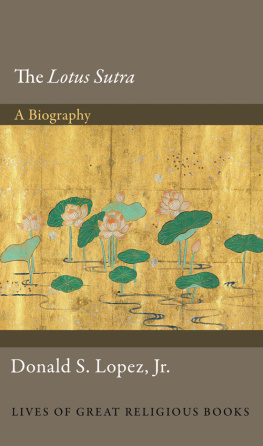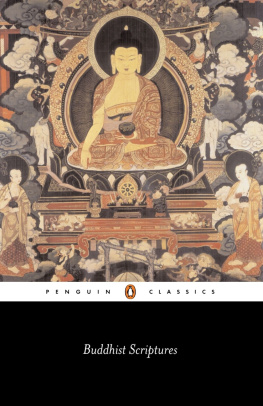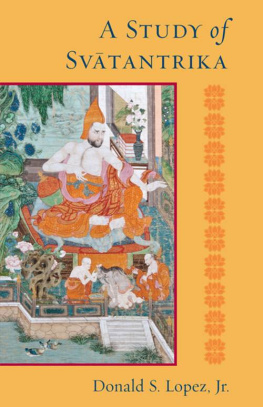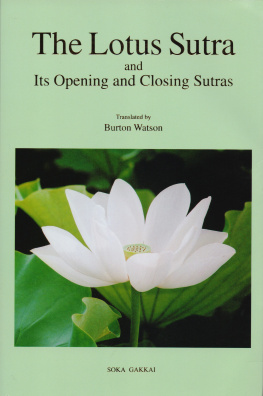LIVES OF GREAT RELIGIOUS BOOKS
The Lotus Stra
LIVES OF GREAT RELIGIOUS BOOKS
The Dead Sea Scrolls, John J. Collins
The Bhagavad Gita, Richard H. Davis
John Calvin's Institutes of the Christian Religion, Bruce Gordon
The Book of Mormon, Paul C. Gutjahr
The Book of Genesis, Ronald Hendel
The Book of Common Prayer, Alan Jacobs
The Book of Job, Mark Larrimore
The Lotus Stra, Donald S. Lopez, Jr.
The Tibetan Book of the Dead, Donald S. Lopez, Jr.
C. S. Lewis's Mere Christianity, George M. Marsden
Dietrich Bonhoeffer's Letters and Papers from Prison, Martin E. Marty
Thomas Aquinas's Summa theologiae, Bernard McGinn
The I Ching, Richard J. Smith
The Yoga Sutras of Patanjali, David Gordon White
Augustine's Confessions, Garry Wills
FORTHCOMING
The Book of Exodus, Joel Baden
The Book of Revelation, Timothy Beal
Confucius's Analects, Annping Chin and Jonathan D. Spence
The Autobiography of Saint Teresa of Avila, Carlos Eire
Josephus's The Jewish War, Martin Goodman
The Koran in English, Bruce Lawrence
Dante's Divine Comedy, Joseph Luzzi
The Greatest Translations of All Time: The Septuagint and the Vulgate, Jack Miles
The Passover Haggadah, Vanessa Ochs
The Song of Songs, Ilana Pardes
The Daode Jing, James Robson
Rumi's Masnavi, Omid Safi
The Talmud, Barry Wimpfheimer
The Lotus Stra
A BIOGRAPHY
Donald S. Lopez, Jr.
PRINCETON UNIVERSITY PRESS
Princeton and Oxford
Copyright 2016 by Princeton University Press
Published by Princeton University Press, 41 William Street,
Princeton, New Jersey 08540
In the United Kingdom: Princeton University Press, 6 Oxford Street,
Woodstock, Oxfordshire OX20 1TR
press.princeton.edu
Jacket art: Universal Gateway, chapter 25 of Lotus Stra, text inscribed by Sugawara Mitsushige, Kamakura Period, 1257. Handscroll: ink, color, and gold on paper, 9 11/16 368 1/16 in. (24.6 934.9 cm). Metropolitan Museum of Art
All Rights Reserved
ISBN 978-0-691-15220-2
Library of Congress Control Number: 2016931669
British Library Cataloging-in-Publication Data are available.
Publication of this book has been aided by the Institute for the Study of Buddhist Traditions at the University of Michigan.
This book has been composed in Garamond Premier Pro
Printed on acid-free paper.
Printed in the United States of America
10 9 8 7 6 5 4 3 2 1
CONTENTS
LIVES OF GREAT RELIGIOUS BOOKS
The Lotus Stra
Introduction
It must have been the spring of 1972. I was in my sophomore year at the University of Virginia. A friend told me that his roommate had invited a Buddhist teacher to come over from Richmond to give a talk at their apartment in town. I decided to go along. I knew nothing about Buddhism. I was taking a course on Hinduism at the time and understood that Buddhism was somehow like Hinduism. In those days, people still used phrases such as Oriental philosophy and Eastern mysticism to subsume the various religious traditions of Asia in a single category. When I arrived at my friend's apartment that night, I was surprised to find that the Buddhist teacher was a white guy, a distinctively unhip white guy. He looked like Matt Foley, the motivational speaker played by Chris Farley on Saturday Night Live. He was dressed in a plaid sport coat, with a white shirt and narrow tie. He wore glasses, and he had short, thinning hair, greased back. He was relatively tall, heavyset, probably in his early fifties. A short Japanese woman was with him, apparently his wife. He gave a brief talk, which I cannot remember. I noticed that in the corner of the room, there was a wooden cabinet sitting on a coffee table. It was about two feet tall. He opened two little doors, and there was a small statue of the Buddha inside. To my amazement, the man got down on his knees, joined his palms together, and started chanting something. We were all supposed to chant along with him. I did not know what it meant or even what language it was.
Later, tea and cookies were served. A guy walked up to me; he was probably in his mid-twenties, someone who had come over from Richmond. He was dressed in the standard uniform of the day, a blue work shirt and bell-bottom jeans. He started telling me about the wonders of chanting. He said, I was walking down the street the other day, chanting to myself. I happened to look down at the sidewalk, andI don't know whether you're into this, manI found an ounce of hash. (Only years later did I learn that Chapter Five of the Lotus Stra is called Medicinal Herbs.)
The white guy in the sport coat was the first Buddhist I ever met. I guess I was expecting something more exotic, perhaps a shaved head and long robes. I didn't know that a Buddhist could look like Willy Loman, carrying in his cases a cabinet with a Buddha inside. I now know that the incomprehensible words that he was chanting were Namu myh renge ky, Japanese for Homage to the Lotus Stra. Millions of Americans would hear Tina Turner chant the phrase on Larry King Live on February 21, 1997.
This is the second book I have written for Princeton's Lives of Great Religious Books series. The first was about The Tibetan Book of the Dead. Despite its great fame, I was disturbed at the thought that it would be the only Buddhist text represented in the series. The Tibetan Book of the Dead, at least the famous version published in 1927, is something of a sham. It is a partial translation of a relatively obscure Tibetan work, purportedly buried in Tibet in the eighth century and unearthed in the fourteenth century, with that translation buried under all manner of odd introductions, notes, and appendices by an American Theosophist named Walter Evans-Wentz (18781965), who named it The Tibetan Book of the Dead (it is called something completely different in Tibetan) because it reminded him somehow of The Egyptian Book of the Dead. For Princeton's prestigious series, I felt that something more authentically Buddhist was required, and thus I agreed to write a book about The Tibetan Book of the Dead if I could choose another Buddhist text to write about as well.
The press agreed, as long as the text was sufficiently famous. What to choose? Buddhism has a huge canonical literature, but it does not have a single signature text, no Daode Jing, no Analects of Confucius, no Bhagavad Gt (and how these became signature texts is something explored in the volumes devoted to them in Princeton's series). Apart from Evans-Wentz's eccentric work, only three Buddhist texts are known by English titles: the Heart Stra, the Diamond Stra, and the Lotus Stra. The first is one page long and certainly rich in meaning, but I had already written two books about it. The Diamond Stra is notoriously difficult to speak about because it is in many ways a critique of speech; as one scholar has noted, when the Buddha's interlocutor Subhti sheds tears of joy at the Buddha's words, the modern reader sheds tears of despair trying to understand what the Buddha means.
The books in Princeton's series are meant to be reception histories of classic texts, accounts of their lives and afterlives. From this perspective, the Lotus Stra seemed the obvious choice: composed in India, making its way to China and then to Japan, its influence and importance building along the way, the first Buddhist stra to be translated from Sanskrit into a European language (French in 1844). It was the first Buddhist stra to appear in an American publication (in Boston, also in 1844), where we read, The book, from which the following extracts are taken, is one of the most venerated, by all the nations, which worship Buddha, and shows very clearly the method followed by the Sage who bears this name. In many ways, it is far more approachable than the
Next page









